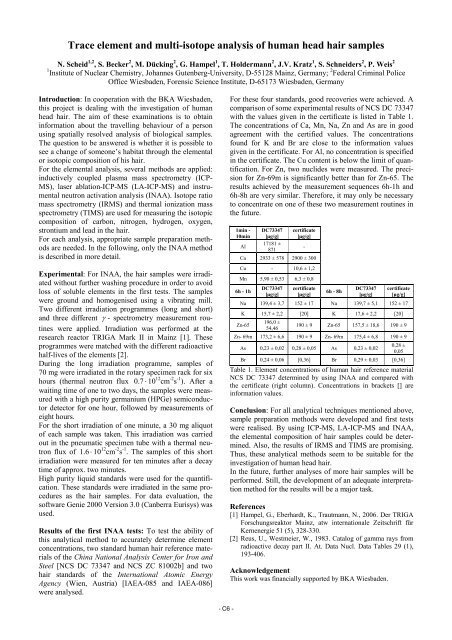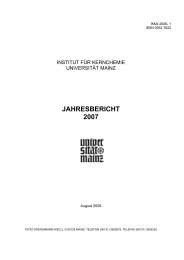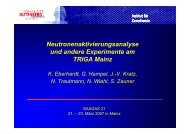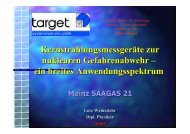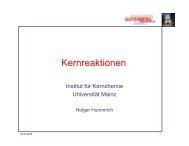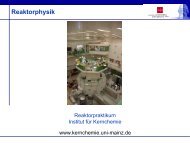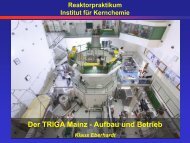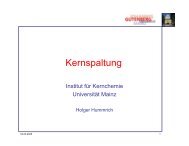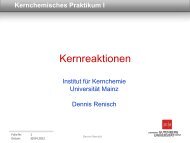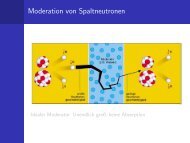institut für kernchemie universität mainz jahresbericht 2009
institut für kernchemie universität mainz jahresbericht 2009
institut für kernchemie universität mainz jahresbericht 2009
You also want an ePaper? Increase the reach of your titles
YUMPU automatically turns print PDFs into web optimized ePapers that Google loves.
Trace element and multi-isotope analysis of human head hair samples<br />
N. Scheid 1,2 , S. Becker 2 , M. Dücking 2 , G. Hampel 1 , T. Holdermann 2 , J.V. Kratz 1 , S. Schneiders 2 , P. Weis 2<br />
1 Institute of Nuclear Chemistry, Johannes Gutenberg-University, D-55128 Mainz, Germany; 2 Federal Criminal Police<br />
Office Wiesbaden, Forensic Science Institute, D-65173 Wiesbaden, Germany<br />
Introduction: In cooperation with the BKA Wiesbaden,<br />
this project is dealing with the investigation of human<br />
head hair. The aim of these examinations is to obtain<br />
information about the travelling behaviour of a person<br />
using spatially resolved analysis of biological samples.<br />
The question to be answered is whether it is possible to<br />
see a change of someone’s habitat through the elemental<br />
or isotopic composition of his hair.<br />
For the elemental analysis, several methods are applied:<br />
inductively coupled plasma mass spectrometry (ICP-<br />
MS), laser ablation-ICP-MS (LA-ICP-MS) and instrumental<br />
neutron activation analysis (INAA). Isotope ratio<br />
mass spectrometry (IRMS) and thermal ionization mass<br />
spectrometry (TIMS) are used for measuring the isotopic<br />
composition of carbon, nitrogen, hydrogen, oxygen,<br />
strontium and lead in the hair.<br />
For each analysis, appropriate sample preparation methods<br />
are needed. In the following, only the INAA method<br />
is described in more detail.<br />
Experimental: For INAA, the hair samples were irradiated<br />
without further washing procedure in order to avoid<br />
loss of soluble elements in the first tests. The samples<br />
were ground and homogenised using a vibrating mill.<br />
Two different irradiation programmes (long and short)<br />
and three different γ - spectrometry measurement routines<br />
were applied. Irradiation was performed at the<br />
research reactor TRIGA Mark II in Mainz [1]. These<br />
programmes were matched with the different radioactive<br />
half-lives of the elements [2].<br />
During the long irradiation programme, samples of<br />
70 mg were irradiated in the rotary specimen rack for six<br />
hours (thermal neutron flux 0. 7 ⋅ 10 12 cm -2 s -1 ). After a<br />
waiting time of one to two days, the samples were measured<br />
with a high purity germanium (HPGe) semiconductor<br />
detector for one hour, followed by measurements of<br />
eight hours.<br />
For the short irradiation of one minute, a 30 mg aliquot<br />
of each sample was taken. This irradiation was carried<br />
out in the pneumatic specimen tube with a thermal neutron<br />
flux of 1. 6 ⋅ 10 12 cm -2 s -1 . The samples of this short<br />
irradiation were measured for ten minutes after a decay<br />
time of approx. two minutes.<br />
High purity liquid standards were used for the quantification.<br />
These standards were irradiated in the same procedures<br />
as the hair samples. For data evaluation, the<br />
software Genie 2000 Version 3.0 (Canberra Eurisys) was<br />
used.<br />
Results of the first INAA tests: To test the ability of<br />
this analytical method to accurately determine element<br />
concentrations, two standard human hair reference materials<br />
of the China National Analysis Center for Iron and<br />
Steel [NCS DC 73347 and NCS ZC 81002b] and two<br />
hair standards of the International Atomic Energy<br />
Agency (Wien, Austria) [IAEA-085 and IAEA-086]<br />
were analysed.<br />
- C6 -<br />
For these four standards, good recoveries were achieved. A<br />
comparison of some experimental results of NCS DC 73347<br />
with the values given in the certificate is listed in Table 1.<br />
The concentrations of Ca, Mn, Na, Zn and As are in good<br />
agreement with the certified values. The concentrations<br />
found for K and Br are close to the information values<br />
given in the certificate. For Al, no concentration is specified<br />
in the certificate. The Cu content is below the limit of quantification.<br />
For Zn, two nuclides were measured. The precision<br />
for Zn-69m is significantly better than for Zn-65. The<br />
results achieved by the measurement sequences 6h-1h and<br />
6h-8h are very similar. Therefore, it may only be necessary<br />
to concentrate on one of these two measurement routines in<br />
the future.<br />
1min - DC73347 certificate<br />
10min [µg/g] [µg/g]<br />
Al<br />
17181 ±<br />
871<br />
-<br />
Ca 2933 ± 578 2900 ± 300<br />
Cu - 10,6 ± 1,2<br />
Mn 5,90 ± 0,53 6,3 ± 0,8<br />
6h - 1h<br />
DC73347<br />
[µg/g]<br />
certificate<br />
[µg/g]<br />
6h - 8h<br />
DC73347<br />
[µg/g]<br />
certificate<br />
[µg/g]<br />
Na 139,4 ± 3,7 152 ± 17 Na 139,7 ± 5,1 152 ± 17<br />
K 15,7 ± 2,2 [20] K 17,6 ± 2,2 [20]<br />
Zn-65<br />
196,0 ±<br />
54,46<br />
190 ± 9 Zn-65 157,5 ± 18,6 190 ± 9<br />
Zn- 69m 173,2 ± 6,6 190 ± 9 Zn- 69m 175,4 ± 6,8 190 ± 9<br />
As 0,23 ± 0,02 0,28 ± 0,05 As 0,23 ± 0,02<br />
0,28 ±<br />
0,05<br />
Br 0,24 ± 0,06 [0,36] Br 0,29 ± 0,03 [0,36]<br />
Table 1. Element concentrations of human hair reference material<br />
NCS DC 73347 determined by using INAA and compared with<br />
the certificate (right column). Concentrations in brackets [] are<br />
information values.<br />
Conclusion: For all analytical techniques mentioned above,<br />
sample preparation methods were developed and first tests<br />
were realised. By using ICP-MS, LA-ICP-MS and INAA,<br />
the elemental composition of hair samples could be determined.<br />
Also, the results of IRMS and TIMS are promising.<br />
Thus, these analytical methods seem to be suitable for the<br />
investigation of human head hair.<br />
In the future, further analyses of more hair samples will be<br />
performed. Still, the development of an adequate interpretation<br />
method for the results will be a major task.<br />
References<br />
[1] Hampel, G., Eberhardt, K., Trautmann, N., 2006. Der TRIGA<br />
Forschungsreaktor Mainz, atw internationale Zeitschrift <strong>für</strong><br />
Kernenergie 51 (5), 328-330.<br />
[2] Reus, U., Westmeier, W., 1983. Catalog of gamma rays from<br />
radioactive decay part II. At. Data Nucl. Data Tables 29 (1),<br />
193-406.<br />
Acknowledgement<br />
This work was financially supported by BKA Wiesbaden.



